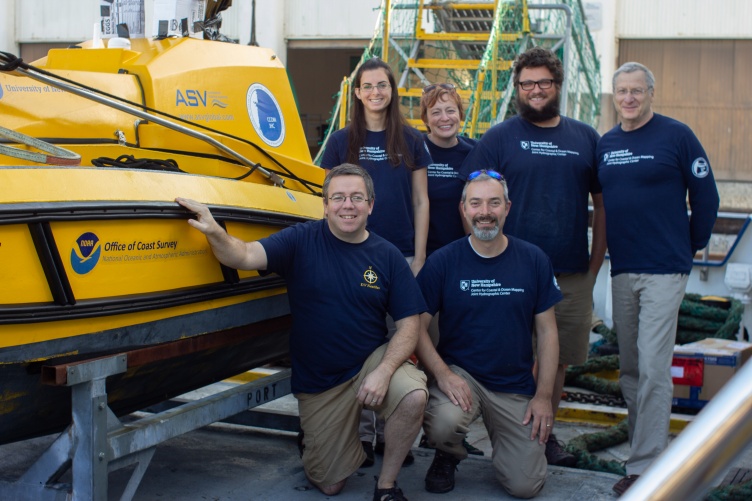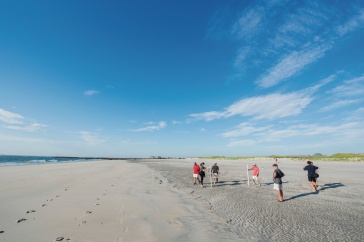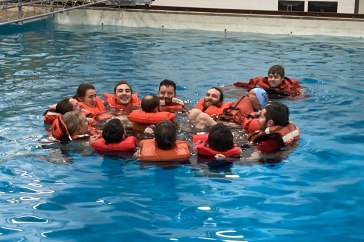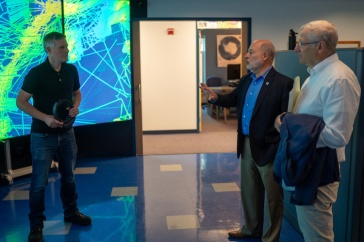
CCOM scientists Roland Arsenault (front left), Val Schmidt (front right), and Ph.D. student Coral Moreno (back left) won an international competition for autonomous ocean-going robotics.
A team of scientists from UNH’s Center for Coastal and Ocean Mapping (CCOM) was awarded the top honor in the international Virtual Ocean Robotics Challenge (VORC) — a university-level competition to explore the capabilities of autonomous ocean-going robotics.
Battling fog, wind, and waves — all simulated on the computer screen, that is — the CCOM team’s virtual competition vessel relied on code they had written to self-navigate and complete a series of challenges on the sea’s surface, receiving input about its surroundings and adapting as needed.
“The tasks that needed to be solved for the competition, like identifying buoys and planning a path around them, were very similar to what we need to do with our own robotic boats — for example, we need to be able to detect lobster pots in our waters and avoid them,” says Roland Arsenault, an autonomous software engineer in CCOM who led the team. “It seemed like a no-brainer for us to participate in the VORC, because the effort we put in for the competition will also apply to our own robotic fleet.”

The VORC was sponsored by Open Robotics, the Naval Post Graduate School and the Office of Naval Research.
The CCOM team’s win capped an intensive effort to prepare for the VORC in a short period of time, and one which drew on the combined experience of its three members: Arsenault; Val Schmidt, a research project engineer who supervises the CCOM Autonomous Systems Group; and Coral Moreno, a Ph.D. student in ocean engineering whose research is focused on helping autonomous surface vehicles perceive their surroundings using various sensors and learn how to avoid collisions based on what they "see".
Of the 13 teams from around the world who competed in the first phase of the competition, only five — including the CCOM team — made it to the second and final phase of the challenge during December 2020. For the safety of its participants due to the coronavirus pandemic, the competition was a virtual one; the simulated venue was the port city of La Spezia, Italy.
Each vessel was “equipped” with stereo cameras, GPS, motion sensors and remote sensing equipment that uses lasers to measure distances called LiDAR. From the comfort of their homes, the teams watched as their vessels worked through the four tasks: station keeping, which is holding a position and heading; wayfinding, which involves navigating to various waypoints; perception, whereby teams identify various buoys and markers; and gymkhana, which combines the three previous tasks to navigate gates, find an underwater pinger in an obstacle field and keep station above it.
The VORC technical team awarded points to the participants based on the speed and accuracy of their task completion. The CCOM team scored highest in the perception task, which was led by Moreno’s efforts and ultimately helped them to eke out a win in the overall competition, beating the second-place team by one point.
"It seemed like a no-brainer for us to participate in the VORC, because the effort we put in for the competition will also apply to our own robotic fleet."
"It seemed like a no-brainer for us to participate in the VORC, because the effort we put in for the competition will also apply to our own robotic fleet."
CCOM scientists have a long history of mapping the seafloor using autonomous surface vehicles and writing the code necessary to make that happen. Despite their combined depth of knowledge, Schmidt says he had some trepidation going into the VORC.
“We’ve never entered a competition like this one before,” he explains. “We were a little apprehensive and unsure that we knew enough to compete, but we thought ‘We’ll learn a lot and we’ve got nothing to lose, so let's do it.’”
Schmidt credits the team’s good working relationship for their success. As the team’s leader, Arsenault set the strategy and framework that fostered good cooperation. Moreno focused on the perception task, where she helped the vessel to detect and classify the objects it had to recognize. Schmidt contributed to the steering and thrust controller and wrote code for the station keeping task. All three team members created practice scenarios in the simulated environment for testing out their solutions to the tasks before the VORC commenced.
Despite signing up for the VORC only two weeks before its start, Arsenault was able to build the virtual robotic framework— the basic communication method for transmitting information between sensors and algorithms – by modifying existing packages to suit the team’s needs for the VORC and saving precious time.
“Being under a time crunch, we put in long hours, working seven days a week,” Arsenault says. “That made it feel a bit like being at sea again where we get to focus on the mission with few interruptions. Since going to sea is something that I haven't been able to do since before the start of the pandemic, this competition served as a good alternative for the moment.”
Schmidt says the strength of UNH’s marine robotics program is derived from the fact that CCOM scientists routinely operate robotic boats at sea, so their software and intuition about what works is always informed by real-world experience. With the exception of the year 2020, CCOM scientists have deployed BEN, the center’s sea-going robotic vessel, aboard NOAA and other research vessels every year since 2016, he explains.
The trio says they hope to be involved in some type of similar experience in the future.
“I think this was a fun, productive and educating experience, and I am grateful for having the opportunity to contribute to the group efforts,” Moreno says. “The most interesting part was to see how all the different pieces come together to something that is complete, and something that can support the research of autonomous systems at CCOM and UNH. I would definitely do it again.”
The Institute for the Study of Earth, Oceans, and Space (EOS) is UNH's largest research enterprise, comprising six centers with a focus on interdisciplinary, high-impact research on Earth and climate systems, space science, the marine environment, seafloor maping, and environmental acoustics. With more than $60 million in external funding secured annually, EOS fosters an intellectua and scientific environment that advances visionary scholarship and leadership in world-class research and graduate education.
-
Written By:
Rebecca Irelan | Institute for the Study of Earth, Oceans, and Space | rebecca.irelan@unh.edu | 603-862-0990



















































